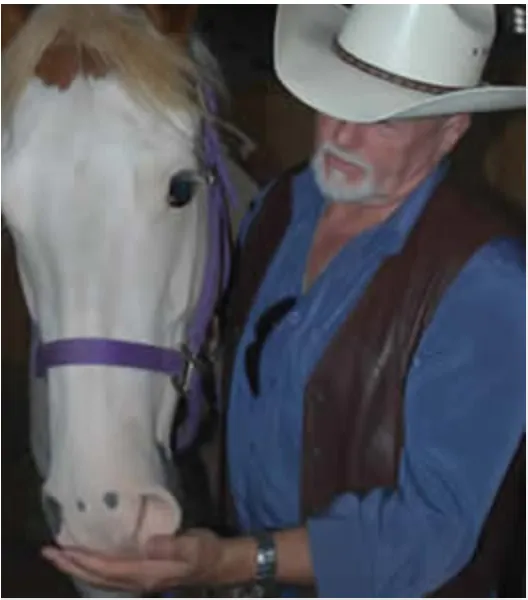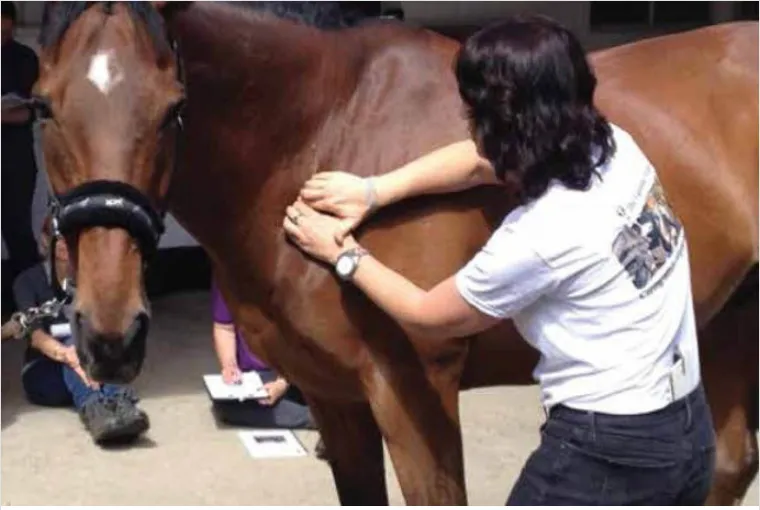Equine Touch
Brad MacClure - 29th October 2024
Equine Touch (ET) is a horse therapy modality started in 1997 by Scotsman Jock Ruddock. Ruddock, who passed away in 2011, was an interesting character. Here’s a brief list of his past occupations:
- Police officer
- Professional wrestler
- Entertainment director
- Hotel manager
- Song writer
- Show writer
- Record producer
- Part time bodyworker.
That last one, by the way, ‘bodywork’, is an alternative therapy which probably deserves its own article.

Jock Ruddock
As a wrestler, Ruddock learned some chiropractic and osteopathic skills. He also trained in Hyperton-X, Kinesiology and Bowen; all modalities which, again, should probably have their own skeptical investigations. Regarding the latter, Ruddock actually took some of his bodywork ideas from Tom Bowen’s work. A user of Equine Touch once told me that ET is basically Bowen Therapy for horses, and it appears there’s some truth to that.
The basic idea is that by vibrating muscles in a specific order and at specific points the body can be induced into a state of ‘medical chaotic confusion’ and also relaxation. These ‘points’ “could be acupuncture points, trigger points or sites of common injuries” (from https://www.theequinetouch.com/what-is-et/).
Ruddock compared his technique on horses to an orchestra tuning up: there’s a very chaotic and dissonant sound while tuning, then they settle down to play in tune and it all sounds as it should. He called his approach “The Vibromuscular Harmonization Technique” (VHT).
To help you get an idea of what’s involved, here’s a short (2 min) video showing ET:
And here’s longer one (24 min):
The explanation on the Equine Touch website of how ET works is quite a list of skeptical red flags. I’d actually started listing the problematic words, but by the end realised I’d more or less copy/pasted the whole thing! So instead I’ll just let you read it for yourself:
“By addressing the meridian pathways, together with muscles and fascia, The Equine Touch crosses the line between physical bodywork and an energy modality. It can have the effect of inducing deep relaxation, releasing hypertonic and traumatised muscles, improving muscle tone, encouraging recovery from injury and muscle atrophy, reducing the pain spiral and assisting in detoxification and lymphatic drainage by increasing circulation. The horse’s awareness is changed and it is encouraged to rebalance not only physically, but emotionally for deep relaxation also encourages the autonomic nervous system to drop toward repair and renewal. Energy blockages and unwanted structures appear to dissolve as the flow of Ki is stimulated through the meridians. This allows the equine to tap into its own innate healing ability and to allow it to work to its maximum potential.”
As you can see, it’s a mashup of pseudoscience, weasel words, and misappropriated or undefined science terminology. Some of those science terms probably have meaning, but I can only assume they don’t want us to know that meaning, or not to think about it too much - judging by the lack of context. Mixed into that word salad are a few real issues horses have that are, or at least could likely be, scientifically identified. Isn’t that just how it goes so often with these things, though? You put a few real known and studied phenomena into the mix, with a whole lot of assumptions and begging the question about the root cause, and then sell your “cure”. For instance, by “hypertonic muscles” they mean muscular hypertonicity, which seems to be a real thing; it’s just that the solution they present doesn’t appear to be backed up by any good evidence. Lymphatic drainage is also a real treatment, although evidence of its efficacy for medical conditions is patchy. The question is what do they mean definitionally by those things, and what is the evidence that ET and VHT fixes them? Yeah, that’s where I came unstuck.
Shall we make a list of pseudoscience terms and weasel words? OK here goes:
Pseudoscientific terms/modalities:
- “meridian pathways”
- “physical bodywork”
- “energy modality”
- “detoxification”
- “energy blockages”
- “ki” (often spelled “qi”)
Weasel words:
- “improving muscle tone”
- “encouraging recovery”
- “reducing the pain spiral”
- “assisting in detoxification”
- “encourages the autonomic nervous system…”
- “unwanted structures appear to dissolve…”
- “the flow of Ki is stimulated”
- “The horse’s awareness is changed and it is encouraged…” (Look, I’m sorry I don’t even know what that’s supposed to mean.)
- “balance” (I’m assuming the horse wasn’t actually falling over?)
- “allows the equine to tap into its own innate healing ability”
As you can see they’ve borrowed heavily from acupuncture and traditional Chinese medicine. They also use the homeopathic-originated word “allopathic” in their disclaimer, which says to me that they either believe in, or at least are appealing to, people who believe in alternative medicine.
A word about case studies
On the Equine Touch website they have a couple of “case studies” you can look at. Let me just say at this point, at the risk of sounding a bit cynical, calling it a “case study” is an easy way to make what is basically a testimonial sound sciency. I’ve struck this before, when I was looking into another horse modality. A case study is a legitimate form of research, but there are many limitations with them. For one thing results are almost never generalisable, meaning that you can’t expect to show efficacy of a treatment with them because you haven’t shown the treatment works on more than one single subject. So showing efficacy is not normally what a case study is for.
Case studies are qualitative, not quantitative. Qualitative means you can get very high quality focused data on one subject/participant, and usually (and this is important) in ‘real world’ type scenarios, as opposed to a lab or controlled environment. They can help you to work out what your controls need to be before you run an experiment or an R.C.T. They can also inform you about what you need to be looking at in future. A case study can be good as a preliminary study.
Now, I’m sorry to be blunt, but in my opinion these are not really case studies in the true scientific sense. These are basically testimonials. That’s OK. We shouldn’t write them off as having zero value, but we also shouldn’t be persuaded by them in the same way as an R.C.T. Testimonials are, in my opinion, a red flag that we might be looking at a modality that is unproven. OK, rant over!

These are basically sweet stories about horses that had a problem, and a variety of things were done with the horse with the goal of fixing them. We don’t know which one or combination of those treatments did the trick, or if none of them did, and the horse getting better was just regression to the mean, but ultimately the implication is that ET fixed him. Bear in mind there are only two stories for the whole of New Zealand. I have to wonder if there’s survivor bias happening here, where we are only seeing the stories with a desirable outcome, ones which can somehow be attributed to our favourite modality. People who spent the money and had very little result to show for it are not likely being encouraged to “leave a review”. Also both of these stories are from a practitioner, so by definition there’s a conflict of interest and bias here.
Another red flag to me is that on the website they basically tell you and me to decide for ourselves how we think it works:
“There are many beliefs and theories on how Equine Touch may work… Our students are encouraged to create their own theory, as they have a different education (in other modalities and techniques) and different beliefs (eastern or western or medical approach).”
So, it’s as if they’re saying we don’t quite know how it works, we are just asking you to believe that it works. I imagine they would say “try it yourself, and if you don’t find it helps then don’t continue with it”.
Also this (same source):
“…one of the most valuable assets of the Equine Touch is its total compatibility to work in a complementary and harmonious synergy with many recognized equine healing modalities including allopathic medicine, acupuncture, homeopathy, herbs, Bach flower remedies, chiropractic and osteopathic.”
There’s that word “allopathic” in there again, by the way, but this to me is interesting. Do you know what else is “compatible” with all these unproven treatments and so-called allopathy? Doing nothing. It’s almost as if this is the same as that.

Ivana Ruddock
Interviews
I endeavoured to conduct interviews with people about ET. ET is very small in NZ, with only about 7 “Practitioners” and 2 “Instructors” listed on the site for NZ. Instructors get to teach courses on how to do it yourself, while practitioners are able to work on others and charge fees. One of the instructors listed is here in Invercargill. I reached out to her but have not, as of yet, heard back.
I did however manage to interview two people. One was a person who has used ET in the past as a client a few times, but no longer uses it. Another was a person who has done ET clinics, levels 1, 2 and 3. The level 3 clinic is taught by Jock’s widow Ivana Ruddock, who, I learned from that interview, is based in New Zealand. I also learned from that interview that doing the clinic to qualify at level 3 involves submitting several ‘case studies’, and that my interviewee submitted these case studies and never heard back. I speculated as to what happened there, and it’s easy to assume that (as I stated above) they’re paying attention to certain types of case studies, and publishing them, while less desirable ones are going in the bin - but it could just be they don’t have a good process in place for the academic side of things, and that the work was overlooked.
Both interviewees had positive things to say about their experience with ET, but were definitely not ‘sold’ on it all the same. The interviews confirmed for me that they, like others, don’t profess to know exactly how ET works. That’s not to say that it doesn’t work. There appears to be something akin to placebo happening. And they do rely on observation after treatment of course. One interviewee stopped using ET because, although they saw a positive result, it was hard to really ascertain that the effect was the result of ET. The other interviewee felt she saw some definite positive results. Both were generally looking for calmer horses, and in one case for lameness to be fixed. I reached out to vet (and former Skeptic’s conference speaker) Mark Bryan, who is also an epidemiologist. I did this because on the ET website they state that many vets, and also the racing industry, use ET. Mark had not heard of ET, but said this:
“It looks typically bs! To be honest, the horse world is full of this sort of stuff, it’s not at all atypical. You might want to use this and a few other equine examples to highlight how wide open the horse world is to quacks”
Conclusion
A big thing about horses is that they’re prey animals:
“Most horses suffer at some time in their lives. These ultimate prey animals have survived for millions of years by hiding all weaknesses, and they continue to hide their problems from us. It is important that we all learn how to recognise the pains and discomforts that plague them.”
This rings very true to me. Horses have evolved to hide their weaknesses (and injuries) as a defence. That’s what makes it hard to assess problems, and it could also be what makes it easy to state that a horse has a problem, and then to state that you’ve fixed it! We mustn’t pretend we know things if we really don’t. Does ET work? Is the VHT a real thing? It might be. It could also be that something therapeutic is happening in the process, but it’s being overblown by extra pseudoscience dressing. I’m inclined to think this is actually the case but, unless it’s properly studied, I fear we won’t ever really know.
